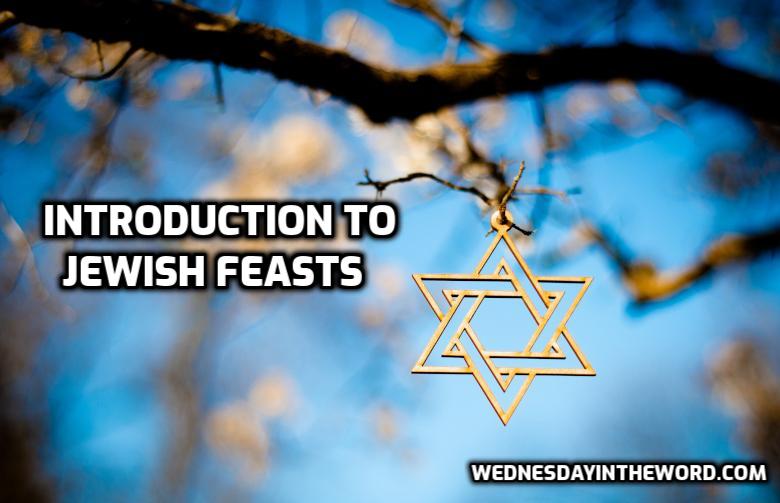In Exodus, God tells the Israelites to keep the Feasts twice: once before the episode with the golden calf and once after. Here’s a summary of the 7 feasts.
Details for the Jewish Feasts are sparse. There are instructions on when the the feasts are to be celebrated, but little information on how (except for Passover). Traditions developed around how to celebrate each feast based on the teachings of the rabbis.
Basics
See: Hebrew4Christians: A Simplified overview of the Feasts of the Lord
Passover (Pesach)
- 1st month (Nisan) Day 14 (Lev 23:4-5); Nisan = March/April.
- Falls on the first full moon of Spring.
- Passover celebrates the Exodus of the Israelites from slavery in Egypt; Exodus 12:6-7)
Unleavened Bread (Chag Hamotzi)
- 1st month Day 15 for 7 days; Lev 23:6-8.
- Runs concurrent with Passover.
- No leaven may be eaten or possessed for 7 days.
First Fruits (Yom habikkurim)
- The day after the Sabbath that occurs during the week of Unleavened bread (Nisan 16-17); Lev 23:9-14.
- A sheaf of barley (the first crop to ripen) waved before the Lord in a prescribed ceremony.
Pentecost (Shavu’ot)
- Also called Feast of Weeks.
- 50 days after Feast of First Fruits (Sivan 6-7; Sivan = May/June); Lev 23:15-22.
- Remembers the giving of the Law seven weeks after the Exodus.
Trumpets (Yom Teru’ah or Rosh Hashanah)
- First day of the 7th month (Tishri 1; Tishri = September/October); Lev 23:23-25
- Celebrated on the first 2 days of the Tishri.
- It marks the beginning of a 10-day period of repentance which culminates in Yom Kippur.
- Trumpet blown.
Day of Atonement (Yom Kippur)
- 10th day of the 7th month (Tishri 10); Lev 23:26-32.
- The holiest day of the Hebrew year.
- This was the only day the High Priest could enter the Holy of Holies and offer sacrifices for the sins of the people.
Tabernacles (Sukkot)
- 7th month, 15th day for 7 days (Tishri 15-22); Lev 23:33-44.
- Also called the Feast of Booths.
- To remember the huts the Israelites lived in during their sojourn in the desert following the Exodus from Egypt.
See Hebrew Calendar
The Feasts and Exodus
I think careful reading of the text indicates the feasts are arranged to commemorate events in Exodus. While this appears to be a minority view, Rabbi Irving Greenberg writes in Jewish Way:
The Exodus is brought into life and incorporated into personal and national values through the classic Jewish behavior model — reenactment of the event. The basic rhythm of the year is set through the reenactment of the Exodus (Passover), followed by the covenant acceptance (Shavuot), and then by a restaging of the exodus way (Sukkot). For the Israelite living in biblical times, the holidays were concentrated in two months: the first month, Aviv, in later times renamed Nissan, which incorporated the seven days of Passover; and the seventh month Eytanim, in later times renamed Tishrei, with one day of Rosh Hashanah, one day of Yom Yippur, seven days of Sukkot and and eight day of closure (Shemini Atzeret). Both months were dominated by the Exodus holidays. The only other annual holiday was Shavuot, which occurred on one day in the third month (page 26).
Feasts and Salvation History
I think each individual feast commemorates a specific Exodus event and commemorates or foreshadows an event in salvation history.
| Feasts | Exodus Event | Salvation Event |
| 1. Spring Feasts: | ||
| Passover (Pesach) | The first Passover | The crucifixion |
| First Fruits (Yom habikkurim) | Crossing the sea | The resurrection |
| Unleavened Bread (Chag Hamotzi) | Flight into the wilderness | Period before the ascension |
| 2. Pentecost (Shavu’ot) | Making the covenant/ giving the law | Coming of the Holy Spirit |
| 3. Fall Feasts: | ||
| Feast of Trumpets (Yom Teru’ah) | Moses returning from Mt Sinai | Second Coming |
| Day of Atonement (Yom Kippur) | Moses asks God to forgive the Israelites | Judgment Day |
| Tabernacles (Sukkot) | Dwelling with God through the wilderness | Dwelling with God in the eternal kingdom |
More: Introduction to…
More: Background & History
Photo by David Holifield on Unsplash

